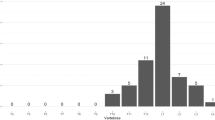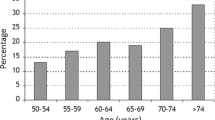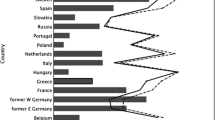Abstract
The aim of this study was to evaluate whether a prevalent vertebral deformity predicts mortality and fractures in both men and women. In the city of Malmö, 598 individuals (298 men, 300 women; age 50–80 years) were selected from the city's population and were included in the Swedish part of the European Vertebral Osteoporosis Study (EVOS). At baseline the participants answered a questionnaire and lateral spine radiographs were performed. The prevalence of subjects with vertebral deformity was assessed using a morphometric method. The mortality during a 10-year follow-up period was determined through the register of the National Swedish Board of Health and Welfare. Eighty-five men and 43 women died during the study period. The subsequent fracture incidence during the follow-up period was ascertained by postal questionnaires, telephone interviews and by a survey of the archives of the Department of Radiology in the city hospital. Thirty-seven men and 69 women sustained a fracture during the study period. Data are presented as hazard ratios (HR) with 95% confidence interval (95% CI) within brackets. Prevalent vertebral deformity, defined as a reduction by more than 3 standard deviations (SD) in vertebral height ratio, predicted mortality during the forthcoming decade in both men [age-adjusted HR 2.4 (95% CI 1.6–3.9)] and women [age-adjusted HR 2.3 (95% CI 1.3–4.3)]. In men there was an increased mortality due to cardiovascular and pulmonary diseases and in women due to cancer. Prevalent vertebral deformity predicted an increased risk of any fracture during the forthcoming decade in both men [age-adjusted HR 2.7 (95% CI 1.4–5.3)] and women [age-adjusted HR 1.8 (95% CI 1.1–2.9)]. Prevalent vertebral deformity predicted an increased risk of any subsequent fragility fracture in women [age-adjusted HR 2.0 (95% CI 1.1–3.5)]; however, in men the increased risk was nonsignificant [age-adjusted HR 1.9 (95% CI 0.7–5.1)]. In summary, a prevalent vertebral deformity can predict both increased mortality and increased fracture incidence during the following decade in both men and women. We conclude that prevalent vertebral deformity could be used as a risk factor in both genders for mortality and future fracture.
Similar content being viewed by others
Author information
Authors and Affiliations
Additional information
Received: 22 March 2002 / Accepted: 27 August 2002
Acknowledgement Financial support was received from the Swedish Medical Research Council K2001-73GX-14080-01 and K2001-73P-14088-01A, the Swedish Society of Medicine, the Swedish Society of Medical Research and the Greta and Johan Kock Foundation.
Rights and permissions
About this article
Cite this article
Hasserius, R., Karlsson, M., Nilsson , B. et al. Prevalent vertebral deformities predict increased mortality and increased fracture rate in both men and women: A 10-year population-based study of 598 individuals from the Swedish cohort in the European Vertebral Osteoporosis Study. Osteoporos Int 14, 61–68 (2003). https://doi.org/10.1007/s00198-002-1316-9
Issue Date:
DOI: https://doi.org/10.1007/s00198-002-1316-9




